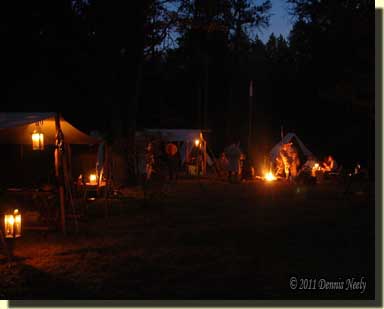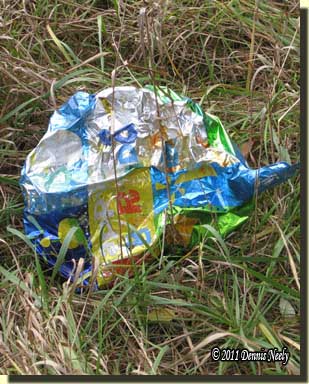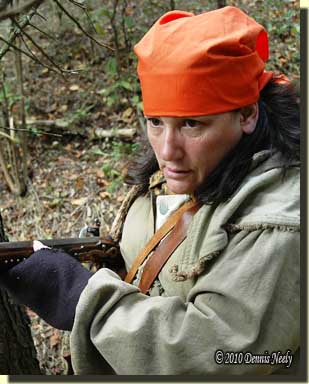“I had with me a deer’s tail, which I showed him [a bleating buck] from behind a tree, and then a small portion of my clothes, which were about the color of a deer. Uncertain what to do, he stood there, occasionally stamping his foot on the ground while holding his head as high as he could. Then I would show the tail quietly, and as if I was not scared; and at last seeing him lick his mouth, I knew he would come to ascertain what was there…” (Browning, 169-170)
Meshach Browning’s words came to mind as the young man’s near-fatal mistake played out on the forum’s post:
“I have always worn orange when I hunted modern,” the post began. Unfortunately, this story is not as uncommon as many traditional black powder hunters would like to think. The writer learned his lesson, or so he said. I’ll refer to him as “Thomas,” rather than use his real name and dredge up past errors.
“I’ve hunted traditional for the last three years,” “Thomas” continued. “I wanted to hunt as authentic as possible…in every part of my gear…to shed everything modern. That’s what I enjoy, getting out there with just what they had. I’ve used hand-woven cloth, natural dyed. All my leather is bark tan or brain tanned.”
In the next two paragraphs “Thomas” recounted the choices he made regarding his persona’s clothing and accoutrements. He gave credit to online posts by respected living historians—some openly scorned the use of hunting orange in any simulation of life in the past. “I’ve been trying to look up to [them], to copy them,” he said. “They’ve had a big influence on me.”
Based on his “mentors” recommendations, “Thomas,” who was twenty years old at the time, chose to forego wearing hunter orange for his traditional hunting adventures. His tale unfolds in the Deep South, and he told how he entered “a remote wilderness area that only my family had permission to hunt.” He still-hunted for a while, then sat. After he eased along a little creek, he plunged into a thick cane stand.
“It was like a smack in the face. I came out of the cane thicket and he was there on the left,” “Thomas” said later. An irate man confronted him. The modern hunter was legally hunting deer on his own property, which was adjacent to the parcel with the cane break. The gent said he saw the cane rustle and thought a deer was approaching that might enter his property. He saw “brown” and peered through his rifle’s powerful scope, but he was horrified when he saw “Thomas.”
“He told me if I would have been wearing hunter orange that wouldn’t have happened. My father had said, ‘your clothing is the color of the deer, and if someone sees that, they’re gonna shoot ya.’
“I started telling my wife about it, but I guess I didn’t think too much how it would affect her. I looked up and she had tears in her eyes, running down her face, and that’s when it really hit me,” “Thomas” said in a quiet tone. “I just got caught up in trying to be too authentic and never should have put my life on the line. I will be getting a hunter orange weskit, or such, in the future.”
The similarity between Meshach Browning’s words, “…my clothes, which were about the color of a deer…,” and those of “Thomas’” father, “your clothing is the color of the deer…,” is striking. First, from a living historian’s perspective, “Thomas” emulated an 18th-century woodsman in an authentic and believable manner. Second, the ultimate result of his portrayal, setting aside the fact that his actions were illegal in a 21st-century context, put him in a serious life-threatening predicament. Such circumstances are avoidable and not necessary when one wishes to experience the texture of life in a chosen bygone era.
The Hunter Orange vs. Authenticity Debate
 When I first embarked on writing about my traditional black powder hunting experiences, I sought out others who shared the passion for re-living the past through fair-chase hunting. I wanted to make sure my perspective was in step with others in the hobby.
When I first embarked on writing about my traditional black powder hunting experiences, I sought out others who shared the passion for re-living the past through fair-chase hunting. I wanted to make sure my perspective was in step with others in the hobby.
Several “experts” whom I respected scoffed at my questions; one well-known individual in particular half-laughed, shook his head and began chastising me for my stupidity. “Any shooter who owns a set of skins, loves American history and hunts” combined those three elements in some form of traditional hunt. Based on his perception, seeking out other traditional hunters was an easy task. “In muzzleloading,” he chided, “everyone hunts traditional.”
Well, instead of willing traditional black powder hunters falling from the trees, eager to share their many tales, my humble inquiries embroiled me in some pretty heated hunter orange discussions. Now I didn’t wander lodge to lodge yelling, “Hunter orange! Hunter orange!” Rather, as I explained my purpose the general disdain for hunter orange entered the conversation within the first few sentences, sometimes spoken of in a quiet manner, and sometimes quite forceful.
I hit a raw nerve among a fair number of living historians. The percentage of folks was much higher than I expected, almost fifty percent. The most common response was, “I don’t hunt traditional, because hunter orange isn’t authentic.” The arguments are many and varied. For some, wearing hunter orange on a traditional hunt is an act of heresy, a desecration of “authenticity.”
In hindsight, I came to discover that these attitudes found their way into a fair number of online chats and forums. Several such posts by revered greybeards almost widowed an innocent young wife. Rather than compromise, these staunch protectors of authenticity babble on, failing to realize or accept the potentially fatal consequences of their rigid doctrine. A traditional hunting accident leaves an indelible scar on the hobby, but beyond that, what of the pain and suffering of the surviving loved ones, both those of the shooter and the victim?
Crushed Pop Cans and Jet Planes
Linen and leather clad woodsmen sat in awe around a dancing campfire. One of their lot recounted every twist and turn of a memorable scout through the Cumberland River watershed. In the midst of the story, he focused on two crushed pop cans that littered the trace. His comments turned into a mild rant about how someone else’s careless act ruined his time traveling adventure. Someone spoke up, “That is your own fault.”
 The reality of any traditional black powder hunt is that our simple 18th-century pursuits are played out on a 21st-century stage. Documented authenticity clashes with modern intrusions all the time; crushed pop cans, jet planes, woven wire fences or a garbage truck’s shrill backup alarm are but a few of the intrusions that come to mind. And there are safety issues, too, like hunter orange.
The reality of any traditional black powder hunt is that our simple 18th-century pursuits are played out on a 21st-century stage. Documented authenticity clashes with modern intrusions all the time; crushed pop cans, jet planes, woven wire fences or a garbage truck’s shrill backup alarm are but a few of the intrusions that come to mind. And there are safety issues, too, like hunter orange.
For some living historians like the gentleman that spoke up, measured compromise helps strike the appropriate balance between “what was” and “what is.” The process starts with a mental attitude that accepts the fact that no history-based simulation will ever be perfect. When a non-period-correct circumstance arises, be it a minor infraction or a serious safety-related concern, one’s mind must measure the threat, then seek a compromise that minimizes the adverse impact of that distraction or danger on the historical integrity of the scenario.
With care and nurturing, any living historian or traditional hunter can develop a mental vigilance that monitors the importance and inherent risk associated with each transgression before conscious awareness intrudes on the 18th-century moment, be it pristine or ordinary.
Willing Hunter Orange Invisible
Norm Blaker is a renowned exhibition primitive archer and long-time traditional black powder hunter. He’s hunted with longbow and flintlock in many states and provinces. His expertise and outdoor exploits border on legendary. He is quick to point out the inconsistencies in the hunter orange laws in the states where he has hunted, and he works to improve those regulations. When Blaker ventures over time’s threshold, his mental attitude transcends the arguments of the authenticity naysayers. “I try not to let it interfere with my fun and relaxation,” he says. “It’s all within the individual’s mind.”
Blaker is quick to voice his concern for keeping safety issues foremost, respecting the game regulations, adhering to high ethical standards, and for promoting a positive example for outdoorsmen and women of all ages.
“How can I go into a school classroom to teach the children about our heritage, about hunting, about enjoying long bows or muzzleloaders and tell kids that it’s important to obey the laws, if I don’t do it myself?” he asked.
But compliance to game laws is not always easy. As Blaker points out, the rules and regulations vary from state to state and from species to species. A state’s game laws require careful reading on the part of the traditional black powder hunter. Due to the unique nature of our hobby, an extra effort is needed, because the ultimate responsibility for understanding and complying with all of a state’s statues rests with the individual.
Once understood, a living historian must go about the task of incorporating sufficient hunter orange into his or her hunting garment choices. I use the word “sufficient,” because for me there are two practical standards that must be addressed. The first is complying with the letter of the law, and the second is adhering to the expected use of hunter orange, based on local conditions. The latter circumstance, which takes into account the additional dangers of a specific geographical area, often surpasses the requirements of the first.
For example, Michigan’s “Hunter Orange Clothing Requirements” state a person must wear “a cap, hat, vest, jacket, or rain gear of hunter orange.” Hunter orange camouflage must be “not less than 50 percent hunter orange.”
 After discussing the historical ramifications of a “head scarf” with the Michigan Department of Natural Resources Law Division, they conferred that the head scarf constituted a cap or hat. An orange tuque, or voyageur cap—the 1790 version of today’s stocking cap—meets the requirement in cold weather. And for Msko-waagosh, the returned white captive who grew up as an adopted son of an Ojibwe family, an orange wool Great Lakes style hood complies as well.
After discussing the historical ramifications of a “head scarf” with the Michigan Department of Natural Resources Law Division, they conferred that the head scarf constituted a cap or hat. An orange tuque, or voyageur cap—the 1790 version of today’s stocking cap—meets the requirement in cold weather. And for Msko-waagosh, the returned white captive who grew up as an adopted son of an Ojibwe family, an orange wool Great Lakes style hood complies as well.
In group settings or on some public lands, the “basics” are not enough. In those situations, I add a reversible orange sleeveless waist coat, which is an example of the second consideration, local hunting practices.
And as a word to the wise, carrying a loaded muzzleloader on an historical trek or scout without any intent of hunting might be allowed in one state and not another. The first state’s regulations might not require hunter orange, while the second would. Along this same line of thought, one or more hunting licenses might be required in one state and none in another.
The issue of what species of game you are hunting comes into play, as well. In a recent post, “A Circuitous Still-Hunt,” that day’s opening hunt was for fall wild turkeys, which did not require hunter orange. When the hens and gobblers did not cooperate, the hunt shifted to squirrels, a small game animal that requires hunter orange. I carry a hunter orange silk scarf in anticipation of such happenstances. Donning the head scarf is a 1790s act of general occurrence; a splash of measured compromise turns the color irrelevant.
And then there is the question of how does a living historian legally handle the situation when a backcountry persona, wearing a garment of hunter orange, kills a squirrel or two and a young hen or jake clucks just over the rise. If this woodsman removes his or her hunter orange and sets up for a wild turkey ambush, he or she is still in possession of two dead squirrels, but not legally wearing orange.
My trading post hunter persona has stumbled into this predicament on a couple of occasions. The game is removed to the pickup and the truck is locked. A strong argument can be made that this ends the squirrel hunt. Then off a traditional woodsman goes on the next hunt, a turkey chase, sans hunter orange. But again, one is at the mercy of the interpretation of the DNR officer, and perhaps a judge. Unfortunately, not all hunter orange situations are black and white.
Incorporating modern hunting regulations within a traditional hunter’s historical simulation is not as difficult as it sounds. As Norm Blaker said, and the woodsman at the campfire implied, “It’s all within the individual’s mind.” You see your own hunter orange and allow the distraction to upset a well-crafted scenario, or you will the color invisible.
To my way of thinking, the utter joy of sharing the exhilarating kinship of a simple pursuit with a hunter hero lurking close by far outweighs the “I don’t hunt traditional, because hunter orange isn’t authentic” reasoning. Plus the outdoor clothing of the modern hunter is ill-fitting and displays an atrocious fashion sense, judged by 1790 standards, of course.
Give traditional black powder hunting a try, be safe and may God bless you.
